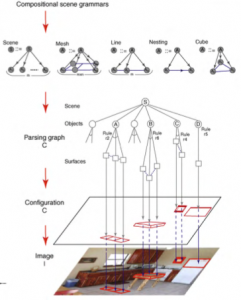Python is easy to use and pretty solid across platforms. Drew Conway has written an essential list of python tools for social science researchers. From running experiments to analysis and modelling, Python can do practically anything you’d ever want, mostly in two or three lines. Hooray!
Author: Sean
Kre-8-iv Spell!ng
A new blog about spelling conventions and change:
http://a2dez.com/
Top-down vs bottom-up approaches to cognition: Griffiths vs McClelland
There is a battle about to commence. A battle in the world of cognitive modelling. Or at least a bit of a skirmish. Two articles to be published in Trends in Cognitive Sciences debate the merits of approaching cognition from different ends of the microscope.

On the side of probabilistic modelling we have Thom Griffiths, Nick Chater, Charles Kemp, Amy Perfors and Joshua Tenenbaum. Representing (perhaps non-symbolically) emergentist approaches are James McClelland, Matthew Botvinick, David Noelle, David Plaut, Timothy Rogers, Mark Seidenberg and Linda B. Smith. This contest is not short of heavyweights.
However, the first battleground seems to be who can come up with the most complicated diagram. I leave this decision to the reader (see first two images).
The central issue is which approach is the most productive for explaining phenomena in cognition. David Marr’s levels of explanation include the ‘computational’ characterisation of the problem, an ‘algorithmic’ description of the problem and an ‘implementational’ explanation which focusses on how the task is actually implemented by real brains. Structured probabilistic takes a ‘top-down’ approach while Emergentism takes a ‘bottom-up’ approach.
Continue reading “Top-down vs bottom-up approaches to cognition: Griffiths vs McClelland”
Fun Language Experiment: Results
Two days ago I ran a pilot experiment online from Replicated Typo. Thanks to all who took part. It’s a bit cheeky to exploit our readers, but it’s all in the name of science. Unfortunately, the pilot was a complete failure. Suggestions and comments are welcome.
The experiment was into the role of variation in language learning. Here’s what I was up to (plus the source code for running similar experiments):
Fun Language Experiment!
I’m running a fun language evolution experiment online! You can take part – it only takes 4 minutes. Once I get enough participants, I’ll post the results right here on ReplicatedTypo.
(You’ll need sound enabled)
UPDATE
The experiment is complete, see the results here.
Cross-species signaling
One of the conundrums of language is why an individual would give away information. Humans appear desperate to tell people about things. Animals, on the other hand, aren’t that interested in communicating beyond basic signalling for survival. However, the wildlife video below points out another problem: Even if an animal has a desire to communicate, others might not want to listen.
This video captures the difficulty of trying to make yourself understood through arbitrary signalling systems, and the relative ease of gesture.
Something I didn’t know was that Hedgehog spines, as well as being protective, evolved so that they can be vibrated as a form of signalling.
Mutual Exclusivity in the Naming Game
The Categorisation Game or Naming Game looks at how agents in a population converge on a shared system for referring to continuous stimuli (Steels, 2005; Nowak & Krakauer, 1999). Agents play games with each other, one referring to an object with a word and the other trying to guess what object the first agent was referring to. Through experience with the world and feedback from other agents, agents update their words. Eventually, agents are able to communicate effectively. The model is usually couched in terms of agents trying to agree on labels for colours (a continuous meaning space). In this post I’ll show that the algorithms used have implicit mutual exclusivity biases, which favour monolingual viewpoints. I’ll also show that this bias is not necessary and obscures some interesting insights into evolutionary dynamics of langauge.
Basic word order and Uniform Information Density
This week we had a talk by visiting PhD student Luke Maurits about basic word order. The distributions of basic word orders around the world (Subject-Verb-Object, Subject-Object-Verb etc. ) has been the focus of much attention. The overwhelming majority of languages have SOV and SVO orders, with fewer having VSO and very small numbers having OVS and OSV. In order of frequency, this is:
(SOV, SVO) > VSO > (VOS, OVS) > OSV
A standard approach has been to assume that this ordering reflects an ordering of functionality: Somehow, SOV order is more functional or efficient or intuitive than OSV. However, Maurits points out that the literature on diachronic change opposes this view. Languages often change from SOV to VSO or SVO over time, but rarely the other way around (see diagram below).
Continue reading “Basic word order and Uniform Information Density”
Evolution of Batman
With the scary season coming up, thoughts naturally turn to bats, and what better bat than the Caped Crusader himself, Batman? Everybody knows the symbol of the Dark Knight, but would you know Tim Burton’s Logo from Christopher Nolan’s? Here’s a video that traces the evolution of Batman’s symbol over his 60 year history.
Sexual Selection in the age of Mass Media
This month a red deer was crowned as Emperor of Exmoor and Britain’s largest wild animal in a series of newspaper articles. Today, it’s emerged that the deer has been shot by a hunter willing to pay the presumably high price on the hunting rights.
 When Richard Austin, the photographer that took the pictures for the articles, was asked if he felt responsible, he said that he always believed the size of the deer’s antlers would get him killed in the end. The Emperor’s antlers may have kept other deer away, but it attracted far deadlier predators. Humans have been breeding animals – and killing them – for sport for a long time, but it’s only recently that prize targets can be advertised so widely. The size of the antlers may be a product of sexual selection, but now cultural processes are counteracting this. The Emperor was even killed during the mating season, unable to pass on its genes. If you’re a deer, it’s maybe best to stay mid-size rather than risk the growing threat of trophy-hunting.
When Richard Austin, the photographer that took the pictures for the articles, was asked if he felt responsible, he said that he always believed the size of the deer’s antlers would get him killed in the end. The Emperor’s antlers may have kept other deer away, but it attracted far deadlier predators. Humans have been breeding animals – and killing them – for sport for a long time, but it’s only recently that prize targets can be advertised so widely. The size of the antlers may be a product of sexual selection, but now cultural processes are counteracting this. The Emperor was even killed during the mating season, unable to pass on its genes. If you’re a deer, it’s maybe best to stay mid-size rather than risk the growing threat of trophy-hunting.
